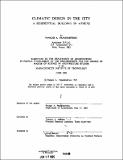| dc.contributor.advisor | Timothy E. Johnson. | en_US |
| dc.contributor.author | Papadimitriou, Panagis A | en_US |
| dc.contributor.other | Massachusetts Institute of Technology. Dept. of Architecture. | en_US |
| dc.coverage.spatial | e-gr--- | en_US |
| dc.date.accessioned | 2013-01-23T19:30:47Z | |
| dc.date.available | 2013-01-23T19:30:47Z | |
| dc.date.copyright | 1985 | en_US |
| dc.date.issued | 1985 | en_US |
| dc.identifier.uri | http://hdl.handle.net/1721.1/76392 | |
| dc.description | Thesis (M.S.)--Massachusetts Institute of Technology, Dept. of Architecture, 1985. | en_US |
| dc.description | MICROFICHE COPY AVAILABLE IN ARCHIVES AND ROTCH. | en_US |
| dc.description | Includes bibliographical references (leaf 119). | en_US |
| dc.description.abstract | The scope of this study is to examine the potential limitations and specific methods which can be used in applying climatic design principles in a densely populated urban environment. For illustrative purposes. a typical multi-story residential building in downtown Athens. Greece. will be used as a case study. Its goal is to use the rich and ever increasing vocabulary of climatic design in order to enhance the dialogue between the urban building and the physical environment as perceived through our senses. The first part analyzes the relationship between man. climate and architecture. and studies the basic principles of energy conscious design. The second part examines issues related to the urban and climatic environment of Athens in order to give an overview of the general context of the case study. This is followed by the description of a building that will constitute the basis for the proposed redesign. Finally. the third part discusses the application of climatic design principles on the proposed redesign. using techniques suitable to the specific climatic and environmental conditions. and provides a synthesis of the issues examined into a comprehensive design proposal. This part concludes with the author using the appraisal of specific improvements on the building to comment on the potential and limitations of this design approach to architecture and urban planning. | en_US |
| dc.description.statementofresponsibility | by Panagis A. Papadimitriou. | en_US |
| dc.format.extent | 119 [i.e. 121] leaves | en_US |
| dc.language.iso | eng | en_US |
| dc.publisher | Massachusetts Institute of Technology | en_US |
| dc.rights | M.I.T. theses are protected by
copyright. They may be viewed from this source for any purpose, but
reproduction or distribution in any format is prohibited without written
permission. See provided URL for inquiries about permission. | en_US |
| dc.rights.uri | http://dspace.mit.edu/handle/1721.1/7582 | en_US |
| dc.subject | Architecture. | en_US |
| dc.title | Climatic design in the city : a residential building in Athens | en_US |
| dc.title.alternative | Residential building in Athens | en_US |
| dc.type | Thesis | en_US |
| dc.description.degree | M.S. | en_US |
| dc.contributor.department | Massachusetts Institute of Technology. Department of Architecture | |
| dc.identifier.oclc | 13172626 | en_US |
